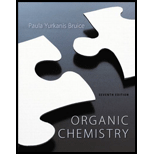
Concept explainers
(a)
Interpretation:
From given pair of reactions the reaction which takes place more rapidly is to be identified.
Concept Introduction:
The SN2/E2 reaction of
An SN2 reaction of an alkyl halide is favoured by a high concentration of a good protic polar solvent.
(b)
Interpretation:
From given pair of reactions the reaction which takes place more rapidly is to be identified.
Concept Introduction:
The SN2/E2 reaction of alkyl halide is with neutral nucleophile/base, the increasing polarity of the solvent will increase the rate of the reaction is to be identified.
An SN2 reaction of an alkyl halide is favoured by a high concentration of a good protic polar solvent.
(c)
Interpretation:
From given pair of reactions the reaction which takes place more rapidly is to be identified.
Concept Introduction:
The SN2/E2 reaction of alkyl halide is with neutral nucleophile/base, the increasing polarity of the solvent will increase the rate of the reaction is to be identified.
An SN2 reaction of an alkyl halide is favoured by a high concentration of a good protic polar solvent.
(d)
Interpretation:
From given pair of reactions the reaction which takes place more rapidly is to be identified.
Concept Introduction:
The SN2/E2 reaction of alkyl halide is with neutral nucleophile/base, the increasing polarity of the solvent will increase the rate of the reaction is to be identified.
An SN2 reaction of an alkyl halide is favoured by a high concentration of a good protic polar solvent.
(e)
Interpretation:
From given pair of reactions the reaction which takes place more rapidly is to be identified.
Concept Introduction:
The SN2/E2 reaction of alkyl halide is with neutral nucleophile/base, the increasing polarity of the solvent will increase the rate of the reaction is to be identified.
An SN2 reaction of an alkyl halide is favoured by a high concentration of a good protic polar solvent.
Want to see the full answer?
Check out a sample textbook solution
Chapter 9 Solutions
Organic Chemistry; Modified MasteringChemistry with Pearson eText -- ValuePack Access Card; Study Guide and Student Solutions Manual for Organic Chemistry, Books a la Carte Edition (7th Edition)
- Hi, I need your help with the drawing, please. I have attached the question along with my lab instructions. Please use the reaction from the lab only, as we are not allowed to use outside sources. Thank you!arrow_forwardHi, I need your help i dont know which one to draw please. I’ve attached the question along with my lab instructions. Please use the reaction from the lab only, as we are not allowed to use outside sources. Thank you!arrow_forward5. Write the formation reaction of the following complex compounds from the following reactants: 6. AgNO₃ + K₂CrO₂ + NH₄OH → 7. HgNO₃ + excess KI → 8. Al(NO₃)₃ + excess NaOH →arrow_forward
- Indicate whether the product formed in the reaction exhibits tautomerism. If so, draw the structure of the tautomers. CO₂C2H5 + CH3-NH-NH,arrow_forwardDraw the major product of this reaction N-(cyclohex-1-en-1-yl)-1-(pyrrolidino) reacts with CH2=CHCHO, heat, H3O+arrow_forwardDraw the starting material that would be needed to make this product through an intramolecular Dieckmann reactionarrow_forward
- Draw the major product of this reaction. Nitropropane reacts + pent-3-en-2-one reacts with NaOCH2CH3, CH3CHOHarrow_forwardIndicate whether the product formed in the reaction exhibits tautomerism. If so, draw the structure of the tautomers. OC2H5 + CoHs-NH-NH,arrow_forwardExplain how substitutions at the 5-position of barbituric acid increase the compound's lipophilicity.arrow_forward
- Explain how substitutions at the 5-position of phenobarbital increase the compound's lipophilicity.arrow_forwardName an interesting derivative of barbituric acid, describing its structure.arrow_forwardBriefly describe the synthesis mechanism of barbituric acid from the condensation of urea with a β-diketone.arrow_forward
 ChemistryChemistryISBN:9781305957404Author:Steven S. Zumdahl, Susan A. Zumdahl, Donald J. DeCostePublisher:Cengage Learning
ChemistryChemistryISBN:9781305957404Author:Steven S. Zumdahl, Susan A. Zumdahl, Donald J. DeCostePublisher:Cengage Learning ChemistryChemistryISBN:9781259911156Author:Raymond Chang Dr., Jason Overby ProfessorPublisher:McGraw-Hill Education
ChemistryChemistryISBN:9781259911156Author:Raymond Chang Dr., Jason Overby ProfessorPublisher:McGraw-Hill Education Principles of Instrumental AnalysisChemistryISBN:9781305577213Author:Douglas A. Skoog, F. James Holler, Stanley R. CrouchPublisher:Cengage Learning
Principles of Instrumental AnalysisChemistryISBN:9781305577213Author:Douglas A. Skoog, F. James Holler, Stanley R. CrouchPublisher:Cengage Learning Organic ChemistryChemistryISBN:9780078021558Author:Janice Gorzynski Smith Dr.Publisher:McGraw-Hill Education
Organic ChemistryChemistryISBN:9780078021558Author:Janice Gorzynski Smith Dr.Publisher:McGraw-Hill Education Chemistry: Principles and ReactionsChemistryISBN:9781305079373Author:William L. Masterton, Cecile N. HurleyPublisher:Cengage Learning
Chemistry: Principles and ReactionsChemistryISBN:9781305079373Author:William L. Masterton, Cecile N. HurleyPublisher:Cengage Learning Elementary Principles of Chemical Processes, Bind...ChemistryISBN:9781118431221Author:Richard M. Felder, Ronald W. Rousseau, Lisa G. BullardPublisher:WILEY
Elementary Principles of Chemical Processes, Bind...ChemistryISBN:9781118431221Author:Richard M. Felder, Ronald W. Rousseau, Lisa G. BullardPublisher:WILEY





